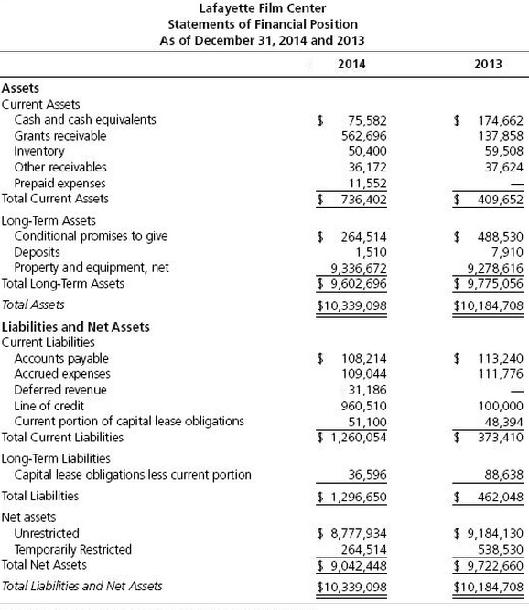Lafayette Film Center (LFC) is a not-for-profit theater that plays independent films. In addition to revenue from
Question:
Lafayette Film Center (LFC) is a not-for-profit theater that plays independent films. In addition to revenue from theater admissions, LFC relies on concession and café sales, grants and other external support, theater rental sales, and proceeds from special events and other programs that not only promote appreciation for independent films, but also generate grants and contributions. LFC’s new executive director has asked you, as the director of finance, to provide an analysis of the organization’s financial position.
1. Does LFC have an endowment? How do you know?
2. How much of LFC’s temporarily restricted net assets were reclassified as unrestricted in 2014? Where can this be found in the statements of financial position and statements of activities?
3. Calculate the four profitability ratios presented in the chapter for LFC for 2014 and 2013, as well as the percent change in each from 2013 to 2014. By which measure did LFC’s profitability deteriorate the most, and by how much?
4. LFC’s total expenses grew by over 100 percent from 2013 to 2014, while its total revenue and other support declined by over 50 percent. Looking at the theater’s statements of activities, a. Excluding interest/ investment income and the one- time sale of tax credits, which three revenue or support categories declined by over 50 percent from 2013 to 2014? b. Which expense category grew by over 100 percent?
5. Calculate LFC’s program services ratio for 2014 and 2013, as well as the percent change in each from 2013 to 2014. Is LFC’s program services ratio for 2014 higher than the commonly accepted benchmark?
6. Given your answers to questions 4 and 5, would you recommend that LFC reallocate some of its spending from program services to fund- raising in 2015? Why or why not?
7. What was LFC’s depreciation expense in 2013 and 2014? Which financial statement( s) provide this information?
8. Now that receivables constitute a much larger proportion of LFC’s assets than in the past, the executive director has asked you to calculate the receivables turnover ratio and average collection period for 2014.
a. Which revenue items will you exclude from the ratio? Why?
b. What is LFC’s receivables turnover ratio and average collection period for 2014? Are they favorable or unfavorable? Why?
c. Would you recommend recalculating the receivables turnover ratio using the average of beginning-of-year and end-of-year receivables in the denominator? Why or why not?

9. Calculate the quick ratio and debt to equity ratio for LFC for 2014 and 2013, as well as the percent change in each from 2013 to 2014. Are these trends favorable or unfavorable? Which presents the greater area of concern for 2014, and why?
10. Given your answers to the questions above and an overall review of LFC’s financial statements, would you characterize LFC’s financial position as weak, neutral, or strong? Why?
Step by Step Answer:

Financial Management for Public Health and Not for Profit Organizations
ISBN: 978-0132805667
4th edition
Authors: Steven A. Finkler, Thad Calabrese





